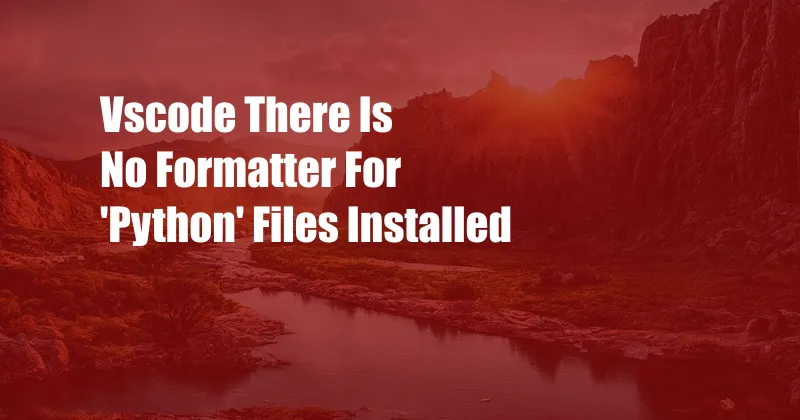
The Ins and Outs of the “No Formatter for Python Files” Error in Visual Studio Code
Visual Studio Code (VSCode) is a powerful, open-source code editor that is popular among developers for its extensive features, extensibility, and user-friendly interface. However, even with its robust capabilities, VSCode users may occasionally encounter issues and errors. One common error that arises is the “There is no formatter for ‘python’ files installed” message.
Unraveling the Error: The Missing Formatter
The aforementioned error in VSCode occurs when attempting to format Python code, but the required formatter is not available or configured properly. Code formatting is an essential aspect of coding, as it helps organize and beautify the written code, ensuring consistency and readability, and facilitating the sharing and collaboration process among developers.
To address this error, it is necessary to install a Python formatter extension within VSCode. The available formatters include autopep8 and black, which can be easily installed from the VSCode Marketplace. Selecting and installing the preferred formatter will enable the automatic formatting of Python code within VSCode.
In-Depth Exploration: What Is a Code Formatter?
A code formatter is a tool that automates the formatting of code, applying predefined formatting rules to ensure consistency and adherence to best practices. This process helps:
- Enhance code readability, making it easier to understand and maintain
- Eliminate formatting inconsistencies, promoting collaboration and code sharing
- Configure and enforce specific formatting styles, ensuring uniformity within a team or project
Latest Developments: Updates and Enhancements
The development of code formatters is an ongoing process, with updates and enhancements continuously emerging. These updates may introduce new features, improve performance, and fix bugs to provide an optimal user experience. Staying abreast of the latest updates is recommended to ensure the efficient operation of code formatters within VSCode.
Tips and Expert Advice: Troubleshooting Formatter Issues
Besides installing a formatter, several other tips and expert advice can aid in resolving “no formatter” errors:
- Ensure the installed formatter is compatible with the Python version used.
- Verify that the formatter’s configuration is correct and matches the project’s requirements.
- Consider manually installing the formatter package using the package manager, as some formatters may not be available through the VSCode Marketplace.
Frequently Asked Questions (FAQs)
Q: How do I install a Python formatter in VSCode?
A: Navigate to the VSCode Marketplace, search for the desired formatter (e.g., autopep8, black), and click the “Install” button.
Q: Which Python formatter is recommended?
A: The choice depends on personal preference and project requirements. autopep8 is popular for adhering to PEP 8 style guidelines, while black enforces a stricter formatting convention.
Q: Can I manually configure the formatter settings?
A: Yes, open the VSCode settings (⌘ + , on macOS), search for the “Python” section, and adjust the formatter configuration options accordingly.
Conclusion: Embracing Consistent and Readable Code
Resolving the “There is no formatter for ‘python’ files installed” error in VSCode by installing a compatible formatter empowers users to enjoy the benefits of automated code formatting. Whether it’s autopep8 or black, selecting the appropriate formatter helps maintain code consistency, improves readability, and facilitates collaborative development. By following the tips and advice outlined in this article, VSCode users can effectively address the error and enhance their Python coding experience.
Interested in learning more about code formatting and its significance? Explore our additional resources and continue your journey towards writing well-structured and easily maintainable code.